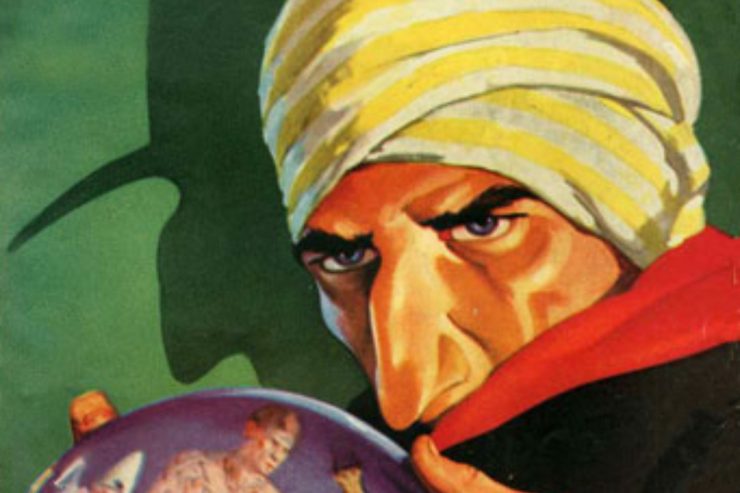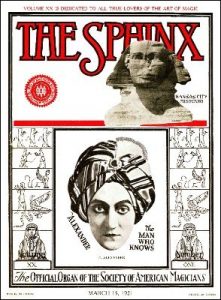 According to his Colgate University biography, Walter B. Gibson “became enchanted with magic at an early age, putting on shows for his family and getting chance meetings with professional magicians. He published his first article, ‘A New Rising Card’ . . . at age 18 for the magic magazine, THE SPHINX. As a Colgate student, Gibson continued to write for magic-themed publications, and by graduation, he’d pulled 217 stories out of a hat. He also performed card tricks — the ‘four ace trick’ was his favorite — for classmates.” In early 1919, Gibson joined the Society of American Magicians.
According to his Colgate University biography, Walter B. Gibson “became enchanted with magic at an early age, putting on shows for his family and getting chance meetings with professional magicians. He published his first article, ‘A New Rising Card’ . . . at age 18 for the magic magazine, THE SPHINX. As a Colgate student, Gibson continued to write for magic-themed publications, and by graduation, he’d pulled 217 stories out of a hat. He also performed card tricks — the ‘four ace trick’ was his favorite — for classmates.” In early 1919, Gibson joined the Society of American Magicians.
After returning to his hometown of Philadelphia, Gibson landed a job as a cub reporter for the NORTH AMERICAN. In 1921, he moved to the PUBLIC EVENING LEDGER and became a feature writer. According to Colgate, “He wrote a daily column, ‘After Dinner Tricks,’ each describing a single magic trick.” He turned selected columns from the series into his first book, AFTER DINNER TRICKS, published in 1921.
On a visit to New York City, Gibson met a traveling magic dealer who asked the young reporter if he’d like to accompany him on a business appointment to the home of Harry Houdini. Although he had met the legendary Houdini briefly at one of the master magician’s shows, this fateful day would begin a six-year relationship between the two. An aspiring magician himself, Gibson served as the illusionist’s assistant, confidante, and ghostwriter. He also helped investigate claims of fraudulent spiritualism. The young Gibson was so well regarded by Houdini and his friends and family, that when the famous magician died unexpectedly in 1926, it was Walter B. Gibson who was granted direct and unlimited access to the master’s private library and notes.
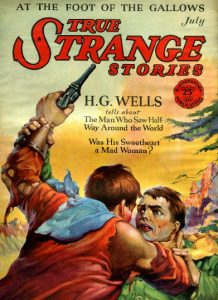 In addition to Harry Houdini, Gibson was also befriended by another great magician of the day, Howard Thurston. He’d do the same some years later with Harry Blackstone. As he had done for Houdini, Gibson became the ghostwriter for both magicians, penning articles and books for them under their names. He also continued to write for magic magazines and newspapers and began contributing “fictionized fact articles” to Macfadden’s TRUE STRANGE STORIES.
In addition to Harry Houdini, Gibson was also befriended by another great magician of the day, Howard Thurston. He’d do the same some years later with Harry Blackstone. As he had done for Houdini, Gibson became the ghostwriter for both magicians, penning articles and books for them under their names. He also continued to write for magic magazines and newspapers and began contributing “fictionized fact articles” to Macfadden’s TRUE STRANGE STORIES.
In late 1930 or early 1931, Frank Blackwell, the editor-in-chief at Street & Smith, was looking for a writer to test the market for a new, single-character magazine. Once known for storypapers and dime novels featuring All-American Boy Frank Merriwell, Buffalo Bill, and other characters, the publisher was interested in establishing a trademark on the popular announcer of THE DETECTIVE STORY HOUR, a weekly radio program that dramatized a short story from each new issue of the publisher’s flagship title, DETECTIVE STORY MAGAZINE. Known as The Shadow, the announcer was “a wicked cackle and a sinister voice” that inspired listeners to ask for “That Shadow magazine” at newsstands.
Enter Walter Gibson, hoping to sell a series of true crime stories to Blackwell. When the editor instead asked for ideas about The Shadow, Gibson mentioned a character that he’d been imagining.
I had been thinking of one who would be a mystery in himself, moving into the affairs of lesser folk much to their amazement. By combining Houdini’s penchant for escapes with the hypnotic power of Tibetan mystics, plus the knowledge shared by Thurston and Blackstone in the creation of illusions, such a character would have unlimited scope when confronted by surprise situations, yet all could be brought within the range of credibility. . . .
Blackwell . . . told me to use my character as The Shadow and pick it up from there, putting The Shadow and his agents on the track of a mystery involving murder and robbery with whatever cross-purpose or false trails I needed. I was to come back with a few opening chapters and a general outline within a week.
Instead of a true-crime series, Gibson left Street & Smith with a magical assignment — create the first hero pulp. And fast!
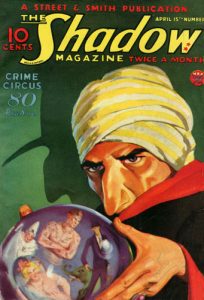 Pulling from his endless imagination and a wealth of direct and indirect information about the world of stage magic and illusion from the adventures of Harry Houdini and Gibson’s other magical friends, Walter Gibson injected the secrets of magic into his creation of The Shadow. It was all there . . . waiting to be put down on paper. Of course, like any good magician, Gibson used misdirection to hide his methods from readers. And for additional effect, Gibson hid behind the names of two magic dealers — Maxwell Holden and U. F. Grant, becoming “Maxwell Grant.”
Pulling from his endless imagination and a wealth of direct and indirect information about the world of stage magic and illusion from the adventures of Harry Houdini and Gibson’s other magical friends, Walter Gibson injected the secrets of magic into his creation of The Shadow. It was all there . . . waiting to be put down on paper. Of course, like any good magician, Gibson used misdirection to hide his methods from readers. And for additional effect, Gibson hid behind the names of two magic dealers — Maxwell Holden and U. F. Grant, becoming “Maxwell Grant.”
Walter B. Gibson would go on to write 283 full-length pulp novels of The Shadow, 187 books, 668 articles, 48 separate syndicated feature columns, and 394 comic books and newspaper strips. He also helped in the development of 147 radio scripts and invented many widely used magic tricks. In 1978, he estimated that he had written 29 million words in his lifetime.
On Saturday, August 21, join PulpFest 2021 as we welcome Tim King for “In the Shadow of Houdini,” a look at the magical secrets of Walter B. Gibson and his stories of the Dark Avenger. Our presentation will take place at the DoubleTree by Hilton Hotel Pittsburgh – Cranberry, beginning at 4 PM.
A lifelong fan of The Shadow, Tim King was introduced to the Orson Welles version by his late mother. “If you like Batman then you’ll love The Shadow.” Did she know that the first Batman story was almost a line for line recreation of Ted Tinsley’s “Partners of Peril?” Only The Shadow knows.
A career investigator for the Department of Defense and US Intelligence Services, Tim spoke at PulpFest 2015 about the similarities between the methods of The Master of Darkness and those employed by the counterespionage services of the same era.
Like Walter Gibson was, Tim is a member of the Society of American Magicians — serving on the paranormal investigations committee, of course. He also belongs to the Office of Strategic Services Society, an organization that honors the historic accomplishments of the OSS during World War II. Tim has written for Sanctum Books, THE SHADOWED CIRCLE fanzine, and moderates THE SHADOW KNOWS Facebook group. His book, IN THE SHADOW OF HOUDINI, is forthcoming.
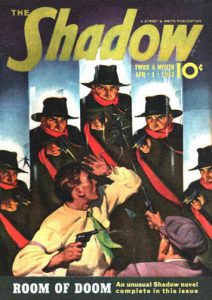
The general public is welcome to attend our evening programming events. To learn more about our programming schedule, please click the Programming button at the top of this page.
For those who also want to enjoy our dealers’ room, you can join PulpFest by clicking the Registration button at the top of this page. And don’t forget to book a room at the DoubleTree. They’re going fast!
The March 15, 1921 issue of THE SPHINX, the official organ of the Society of American Magicians, features a photograph of Alexander the Man Who Knows. Born Claude Alexander Conlin in 1880, he was a vaudeville magician who specialized in mentalism and psychic reading acts. He dressed in Oriental-style robes and a feathered turban and often used a crystal ball as a prop. Walter Gibson began contributing to THE SPHINX at the age of eighteen.
Edited by Webster Scofield, TRUE STRANGE STORIES lasted just eight issues. Walter B. Gibson had articles in four of the issues. Pictured above is the July 1929 number, featuring cover art by F. P. Sylos. Gibson’s article is noted at the top of the cover — “At the Foot of the Gallows.”
Interestingly, Gibson was the founding editor of TRUE STRANGE STORIES but left the position to concentrate on his writing.
Above is George Rozen’s painting of The Shadow . . . the Man Who Knows. It originally appeared as the front cover art for the April 15, 1934 issue of THE SHADOW MAGAZINE, published by Street & Smith, illustrating Walter B. Gibson’s “Crime Circus.” Interestingly, the story features not only a Houdini era secret but a secret that ties back to when Houdini and Gibson first met.
Closing our post is more Shadowy magic by George Rozen. It’s the cover art for the April 1, 1942 issue of THE SHADOW, as the Master of Illusion scares the dickens out of a pair of crooks in Walter B. Gibson’s “Room of Doom.”

